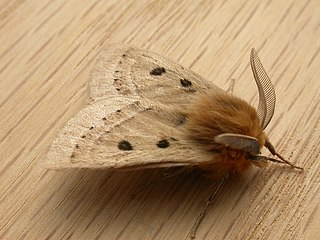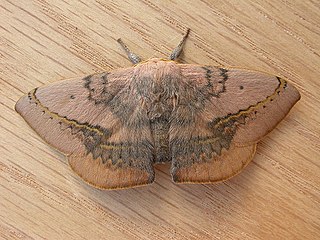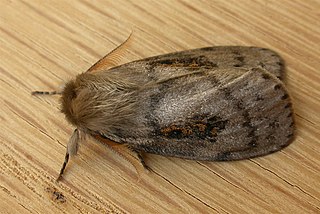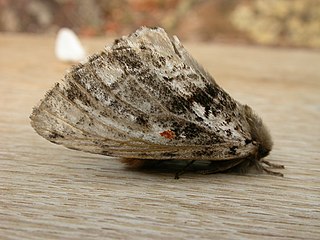
The pasture day moth is a species in the moth family Noctuidae which is active during the day, as its common name implies, making it unlike most other noctuid species. It is found in most southern areas of Australia, ranging from lower Queensland to Tasmania. The species was first described by George French Angas in 1847. It is the only species in the monotypic genus Apina, erected by Francis Walker in 1855.

Notodontidae is a family of moths with approximately 3,800 known species. The family was described by James Francis Stephens in 1829. Moths of this family are found in all parts of the world, but they are most concentrated in tropical areas, especially in the New World.

Amastus is a genus of moths in the family Erebidae. The genus was erected by Francis Walker in 1855.

Lophocampa is a genus of moths in the family Erebidae. The genus was erected by Thaddeus William Harris in 1841. It contains around 75 species.

Thalaina clara, or Clara's satin moth, is a moth of the family Geometridae. The species was first described by Francis Walker in 1855. It is endemic to south-eastern Australia.

Anthela ocellata, the eyespot anthelid, is a moth of the family Anthelidae. The species was first described by Francis Walker in 1855. It is found in Australia, from Bundaberg to Hobart along the east coast.

Anthela varia, the variable anthelid, is a moth of the family Anthelidae. The species was first described by Francis Walker in 1855. It is found in the coastal areas of southern Western Australia, southern Queensland, New South Wales, and Victoria.

Leptocneria reducta, the white cedar moth, is a moth of the subfamily Lymantriinae. The species was first described by Francis Walker in 1855. It is found in all of Australia, except Tasmania.

Pinara divisa, the common pinara, is a species of moth of the family Lasiocampidae. It was first described by Francis Walker in 1855. It is found in the south-east quarter of Australia.

Pinara cana, the neat pinara, is a species of moth of the family Lasiocampidae first described by Francis Walker in 1855. It is found in the south-east quarter of Australia.

Doratifera pinguis, the pale cup moth or sometimes the painted cup moth is a moth of the family Limacodidae. The species was first described by Francis Walker in 1855. It is found over the whole eastern seaboard of Australia.

Iropoca is a monotypic moth genus in the subfamily Lymantriinae erected by Alfred Jefferis Turner in 1904. Its only species, Iropoca rotundata, the iropoca moth, was first described by Francis Walker in 1855. It is found in the Australian states of Victoria, New South Wales and Queensland.
Amata bicolor is a species of moth of the subfamily Arctiinae first described by Francis Walker in 1854. It is found in Queensland, Australia.

Flindersia maculosa, commonly known as leopardwood or leopard tree, is a species of tree in the family Rutaceae and is endemic to inland areas of eastern Australia. It has mottled bark, simple leaves arranged in opposite pairs, white to cream-coloured flowers and fruit studded with rough points.

Porela vetusta, the ancient porela, is a moth of the family Lasiocampidae. It was first described by Francis Walker in 1855. It is found in the Australian states of New South Wales, Queensland, Tasmania and Victoria.

Porela subfasciata, the fasciated porela, is a species of moth of the family Lasiocampidae. It was first described by (Francis Walker in 1855 and is known from the Australian states of Tasmania and Victoria.

Aglaosoma variegata, the patterned notodontid, is a species of moth of the family Notodontidae first described by Francis Walker in 1855. It is known from the Australian states of New South Wales, Queensland and Victoria.

Tifama is a monotypic moth genus in the family Notodontidae erected by Francis Walker in 1855. Its only species, Tifama chera, was first described by Dru Drury in 1773. The species is known from Suriname and Brazil.

Parasa bicolor, the green rice moth, is a moth of the family Limacodidae. The species was first described by Francis Walker in 1855. It is found in Sri Lanka, India, Nepal, Pakistan, Myanmar, Laos, Taiwan, Vietnam, Malaysia, Java, China and Taiwan.

Goodenia bicolor is a species of flowering plant in the family Goodeniaceae and is endemic to north-western Australia. It is an annual or ephemeral herb with lance-shaped to egg-shaped leaves with the narrower end towards the base, racemes of yellow or yellow and purple flowers and elliptical fruit.



















